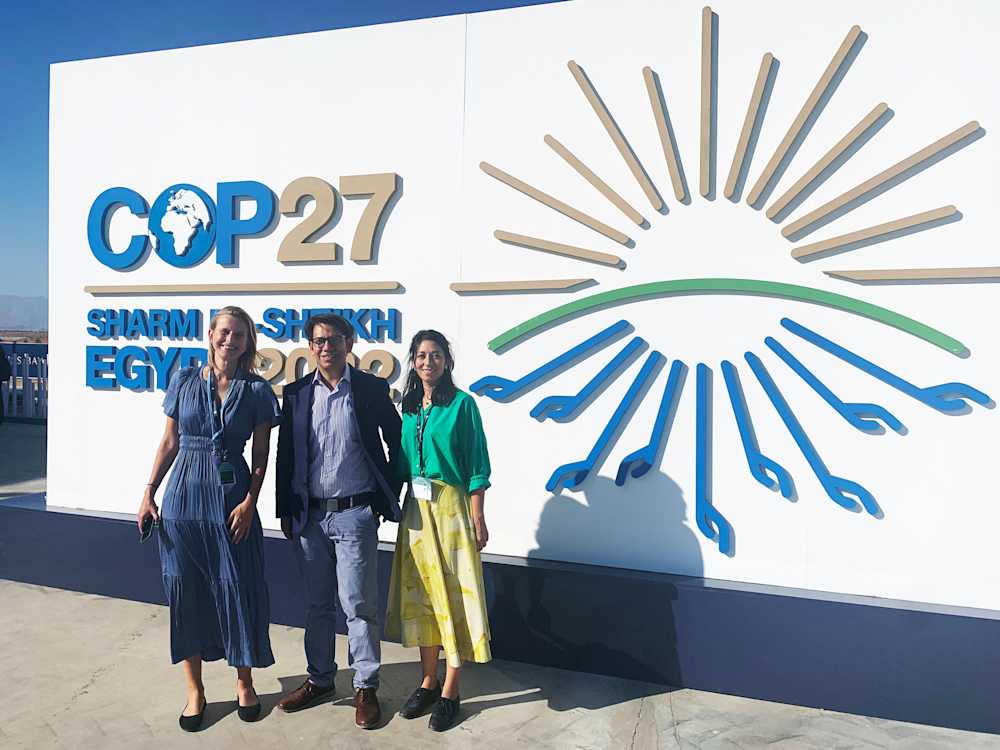Climate Finance and Food Systems Transformation
Five firsthand COP27 takeaways

Since 2007 leaders around the world gather annually at the COP, the Conference of the Parties to the United Nations Framework Convention on Climate Change to discuss climate change and to review and promote implementation of the convention. Our Food Systems and Nature Based Solutions expert, Mauricio Benitez, attended the COP27 to disseminate and mobilize climate finance and food systems transformation. In reflection of the event are five noteworthy and firsthand insights.
A shift in focus to «food systems»
Last year’s COP26 in Glasgow had its spotlight on creating carbon free markets and reducing the world’s dependency on coal in favor of renewable energy, while food and farming was not high on the agenda despite their key roles in cutting emissions and deforestation over the next decades. At the time responsAbility was amongst very few investors looking at this sector when the company’s strategy on climate-smart food systems was launched in Scotland.
This year’s situation was completely different. For the first time, an entire negotiation day focused on agriculture and five pavilions were dedicated exclusively to the role of discussing food and agriculture as part of the Paris Agreement implementation. Dozens of side events, in the form of panels and workshops took place to discuss how mainstream food systems need climate action, alongside energy, transportation and other high-emitting sectors. The efforts resulted in the introduction of a working program on agriculture and food security to be held at future conferences of the parties. Finally, food was back on the menu.
Embracing adaptation is pivotal
An estimated USD$350bn of annual investments are needed to transform the food system, which could generate up to USD4.5tn in new business opportunities. Investors have seen this prospect predominantly through the lens of bringing climate change under control. However, the financing gap is more significant if adaptation is considered. For example, smallholder farmers produce about one third of global food, and will be disproportionately impacted by climate change, yet they only receive 1.7% of global climate finance.
There were emotional exchanges at COP27 on the need to increase funding to make smallholder farmers more resilient and to help pay for climate-related loss and damages. The demand for climate justice from developing countries, resulted in the historic commitment by developed nations to include a final “Loss and Damage” Fund agreement at the COP27. This decision also contributed to the new food initiatives launched, which aim to unlock climate finance to improve resilience of farmers in the southern hemisphere. This with an emphasis on women and youth, while ensuring healthy diets and food security. However, the discussions offered little detail on how to attract and leverage private capital for adaptation, given the high risks of agricultural investments.
Leverage synergies and technologies to finance climate mitigation and adaption
Agricultural practices that increase climate resilience normally also restore carbon in the soil, contributing to climate change mitigation. In leveraging such synergies, financing regenerative practices could partially be supported by the issuance of carbon credits to benefit farmers. At COP27 many maturing initiatives were at display that could help investors tap into new opportunities, including platforms that aim to increase the efficiency of verification in the voluntary carbon market through digitalization and blockchain technologies. By including tokenization of impact outcomes which could include biodiversity and healthy livelihoods, investors, carbon offsets buyers or food corporates could aim to reduce emissions in their value chain. Carbon credits issued by farmers could also support the democratization of climate insurance, promoting incentive systems that reward smallholder farmers for adopting climate-friendly practices with carbon credits.
Climate change is a global problem that needs local understanding
Locally led adaptation was a concept widely discussed to highlight the importance of supporting organizations in developing countries and to strengthen capacities to execute climate change adaptation projects. The problem is very local in nature and solutions should be tailored to each context and situation, in collaboration with local communities. One potential catalyzer of impact in the agriculture sector are local financial institutions, which can scale climate-smart practices through their existing portfolios. But for these organizations to efficiently implement climate change adaptation finance, climate risk assessments and science-based modelling need to be available at granular and geographical level. Although the data is available publicly, it’s imperative that it can easily be interpreted and is incorporated in the risk management, portfolio management and credit assessments of the organizations. Amongst different developments in this space, CGIAR (Consultative Group on International Agricultural Research) presented a practical open-source tool ready for piloting, which should support the widespread use of such models.
Action and clearer focus need to be reinstated at future COPs
We have come a long way since COP26, where responsAbility was referred to as the first science-based climate finance solution targeting food systems. Discussions have also progressed further this year. However, the COP27 significantly increased in size and lack of focus became evident when hundreds of side events competed to ride the proliferation of the net-zero corporate pledges, think tanks, forums and coalitions. The focus on policy implementation needs to return at future conferences before it’s too late.
Scientists estimated in May 2022 that there was a 50 per cent chance that temperature will reach above 1.5C in the next 5 years. This calculation demands immediate attention and rather than leveraging the momentum of general political will to drive progress towards phasing down fossil fuels, the COP27 ended where the COP26 did, with a vague agreement to phase down polluting coal power and phase out inefficient fossil fuel. To keep in line with the targeted 1.5 degrees, the world needs to cut global emissions by 50% within 7 years which makes clear that time is of the essence and COPs need to drive progress as there is no room for stagnation. The currently outlined pledges and reports on progress and concrete achievements made by governments, corporates and investors need to be focal points of future COPs. If global warming is allowed to continue unabated, the world will not be able to afford climate change adaptation finance. There is a renewed, real urgency of the situation and for COP28 to make tangible progress.

Mauricio Benitez
Mauricio Benitez is responsAbility’s Food Systems Lead. He oversees the development and implementation of new investment solutions related to climate finance, sustainable food and natural capital and is currently working on a climate impact investment solution to help address key challenges of the global food system. He joined responsAbility in 2009, after 10 years working in Latin America and Eastern Europe, supporting small banks to improve credit risk management and strategy. Mauricio is a Swiss-Bolivian Economist and holds an MEcon degree from the University of the Western Cape and an MA in Development Management from the Ruhr Universität Bochum.

